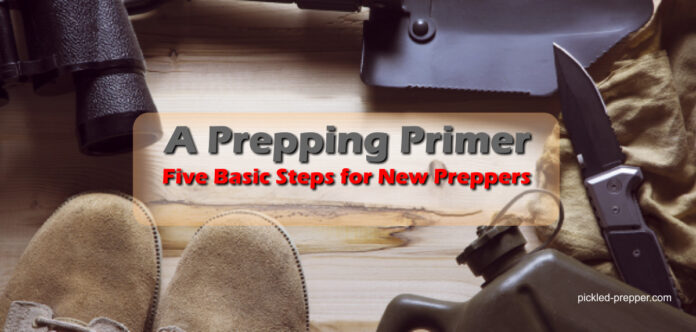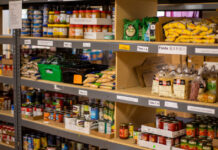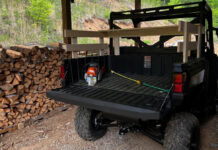This is part two of our series on five steps you should take to prepare. We covered steps one and two yesterday and recommend you read them first.
Step Three: Build To Three Months of Preps
Once you have completed steps one and two, your next step is to bulk up on food. I suggest you set targets: Aim to double your food supply so you have four weeks’ worth of food in your prepper pantry. Then double it again. After achieving two months of food storage, adding another month’s worth of food should be relatively easy.
Storing that much grocery store food means you will have to make things from scratch, so as you build your prepper pantry, start buying bulk bags and packs. When shopping at club stores, you can buy goods in six-packs eight-packs. We even buy ramen in a 48-pack. Then buy larger bags and boxes instead of the one-pound bags usually offered.
For example, buy flour and sugar in 25 pound bags and practice baking from scratch. Practice with bread and similar items, like rolls, flat breads, biscuits, etc. Then learn to make your own pasta and similar items like dumplings. By practicing your baking skills, you will identify things you need, from spices to yeast and baking powder, to cookware. Acquire these items now, as part of your prepping.
I also suggest you buy bags of rice and different kinds of beans and learn to cook different bean dishes. Look into recipes from different geographic regions and cultures to expand your repertoire. Stock up on things you need to cook different recipes.
Once you have this much food on hand, start rotating it. Every month, eat some of your preps and then replace them. This will not only ensure you have fresh food in your prepper pantry, but it will get your family used to eating the same food you store.
Advanced Options
There is more to survival than food storage, so stock some extra cleansers, paper products, hygiene and personal care products, and dental supplies. No one wants to run out of shampoo, but running out of toilet paper would be even worse.
When you have three months of food on hand, you are becoming a serious prepper. You should also consider stocking ammunition and a few guns and get some training. Buy tools you will need to survive in your area or situation. Start building your skills and knowledge by taking training courses. Make sure you have a couple of ways to provide drinking clean water to your family.
Consider becoming a HAM radio operator, or at least getting a shortwave radio. If the grid goes down, you may not get news through traditional sources. Also consider acquiring a few hundred watts of solar power and a couple batteries. You can cobble together them to generate and store solar power, giving you a way to recharge batteries.
Focus on building layers or preps, as we discuss in our section on the layer approach to prepping. Don’t rely on one item or even one type of item. For example, in lighting, our first choice is battery-powered flashlights, headlamps, and lanterns. We also have multi-fuel Coleman lanterns and kerosene lanterns. Finally, we have candles, and we bought wick so we can make more using our own beeswax.
Step Four: Buy Long Term Storage Foods and Prepping Gear
Once you have stored enough grocery store food and other gear to survive unaided for three months, it is time to buy specialty items instead of standard foods. For food, that means buying long-term storage food in #10 cans, five-gallon pails, and six-gallon super pails. All your long-term storage foods should be packed in an oxygen free atmosphere. minimize spoilage and infestation, items in plastic pails should be sealed in Mylar bags.
First, buy bulk foods like wheat, rice, oatmeal, pasta, beans, and powdered milk in plastic buckets. Hard red wheat is recommended for preppers because it has a high protein content and makes better bread than other varieties. I recommend buying at least three buckets of grain and one bucket of beans per family member per year. (You should have at least a year’s worth of food for everyone, and more is OK.)
After you have the buckets, buy #10 cans of dehydrated foods. I would concentrate on powdered eggs, fruits, vegetables, soup mixes, beans, and baking mixes. As you build up a supply of these basics, you can expand into desserts, drink mixes, powdered cheese, and other items.
You can buy the buckets and cans all at once or a little at a time, whatever your budget allows. I recommend you shop around to get the best prices. I also suggest you shop ala cart rather than buying a manufacturer’s one-year kit or bundle. You should pick foods you and your family want and will like and select your own quantities.
Only after you have at least a year’s worth of the long-term storage food basics, should you consider shopping for freeze-dried foods, MREs, and other specialty prepping foods.
Additional Preps
Once you’ve taken care of the food, this is also the stage at which you can fill out your med kit with antibiotics, sutures, and whatever else a nurse or doctor on your medical team recommends. After that, you can buy more ammunition (stack it deep, folks) and some rolls of pre-1965 silver dimes and quarters.
This is also the stage to buy the cool (i.e., expensive) prepping gear you want. I’m talking solar generator or a larger solar-power system, a DC-powered refrigerator that can run on solar power, a freeze dryer, more guns, a four-wheeler, etc.
You can also look at some of the many online lists of things that will be useful for barter and stock up on some of them. I recommend small, inexpensive items like lighters, bars of soap, chapstick, candles, small vacuum-sealed bricks of coffee, tea bags, candy bars, protein or energy bars, and small bottles of alcohol. Not only are these easy to acquire prior to a collapse, you can carry them with you on a patrol and give them out to someone you want to befriend. And if you never barter with anyone, they are items you would not mind having extras. Before you go overboard on barter, check out our article on the best way to barter.
Step Five: Become More Self Sufficient
BY the time you reach this step, you should be pretty darn well proud of yourself. You are better prepped than 98 percent of the country. While you can keep buying and storing food and gear, this step is where you take steps to become more self-sufficient.
One way to do this is to stock up on anything that you might use up or wear out, form nuts and bolts to shoes and sock. Another is to build your skills and expertise in a range of topics that might be useful after the SHTF. This could be anything from blacksmithing to sewing to becoming a paramedic. (Check your local community college; the extent of their continuing education courses might surprise you.)
Another way to do so is to produce your own food by starting a garden or raising livestock. If you have to move to more land to do this, more power to you, but most suburban lots can support a garden, a few chickens, and a couple bee hives.
Keep it Going
I consider prepping to be a lifestyle, and if you have reached this stage, you are living the prepper life. The most important things is to keep the cycle going. Rotate. Restock. Build. Practice. Don’t rest on your laurels.
Look for like-minded souls and build a prepping group, or at least a network of people you feel you can rely on. Don’t advertise your preps, but feel out your friends and see if they are concerned that the world as we know it is rapidly going downhill. Slowly encourage them to prep. Building a prepper network is one of the hardest things to do and must be handled with care.
Knowing who NOT to tell about your preps is also important. If the SHTF and someone bugs out to your house, you want them to be people that are not afraid to pick up a shovel, a spatula, or a gun to help out. The last ones you want are those that whine that they can’t get a signal because the power is out and are in such poor shape they can’t walk a mile.
Five Steps to Success
The best thing about these five steps is that you can stop after each one. They are stages of your prepper evolution. If you stop prepping after completing step three, you are still well prepped. If you never complete stage five, you are still an accomplished prepper.
Prepping is not a race or a competition and is never finished. Go as far as your heart and your wallet can take you.







